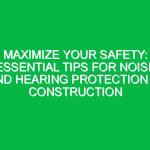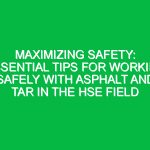In the bustling world of construction, the roar of heavy machinery and the constant movement of vehicles are familiar sounds. However, amidst this cacophony, the paramount concern is always safety. The operation of construction vehicles and equipment poses significant risks not only to the operators but also to the workers on-site and the general public. In this comprehensive guide, we delve into the essential tips and best practices for ensuring safety in the operation of construction vehicles and equipment, a critical aspect of Health Safety and Environment (HSE) management.
Understanding the Importance of HSE in Construction
Before we dive into the specifics, it’s crucial to understand the role of Health Safety and Environment (HSE) in the construction industry. HSE is a discipline and specialty that studies and implements practical aspects of environmental protection and safety at work. In construction, this means creating a work environment that minimizes risks and ensures the health and safety of everyone involved.
Key Strategies for Safe Operation of Construction Vehicles and Equipment
Ensuring the safe operation of construction vehicles and equipment involves a multifaceted approach. Here are the key strategies that should be implemented:
Comprehensive Training for Operators
One of the foundational steps in maximizing safety is providing comprehensive training for all operators. This training should cover not only the basics of operating the machinery but also the specific safety protocols related to each piece of equipment. It’s essential that operators understand the importance of following these protocols to prevent accidents and injuries.
Regular Maintenance and Inspections
A well-maintained machine is a safer machine. Regular maintenance and inspections are crucial to ensure that all construction vehicles and equipment are in good working condition. This includes checking for any mechanical issues that could pose a risk during operation and ensuring that all safety features are functional.
Implementing Safety Protocols
Every construction site should have clear and comprehensive safety protocols in place for the operation of vehicles and equipment. These protocols should be based on industry standards and regulations and should be regularly reviewed and updated as necessary. They should cover everything from the proper use of safety gear to emergency procedures.
Effective Communication Among Team Members
Effective communication is key to maintaining safety on a construction site. Operators, workers, and site managers should be in constant communication to ensure that everyone is aware of the movements of vehicles and equipment. This can help prevent accidents caused by miscommunication or lack of awareness.
Utilizing Technology for Enhanced Safety
Advancements in technology have provided new tools for enhancing safety in the operation of construction vehicles and equipment. This includes everything from GPS tracking systems that help manage the movement of vehicles on-site to safety management software that helps track compliance with safety protocols.
Best Practices for Specific Types of Construction Equipment
While the general strategies for safety apply to all types of construction vehicles and equipment, there are also specific best practices for different types of machinery. Let’s explore a few:
For Cranes and Lifting Equipment
Ensure that all operators are trained and certified in crane operation. Conduct regular inspections of cranes and lifting equipment, and always adhere to the manufacturer’s guidelines for weight limits and operation.
For Earthmoving Equipment
Operators of earthmoving equipment should be especially vigilant about their surroundings, given the size and power of these machines. Establish clear communication protocols to avoid collisions and ensure that all workers are aware of the equipment’s path.
For Power Tools and Handheld Equipment
Even smaller tools can pose significant risks if not used properly. Training should include the correct use of power tools, and all equipment should be regularly inspected for damage or wear that could lead to accidents.
Creating a Culture of Safety
Beyond implementing specific strategies and protocols, creating a culture of safety is perhaps the most important element in ensuring the safe operation of construction vehicles and equipment. This means fostering an environment where safety is everyone’s priority, and all team members feel responsible for not only their safety but also the safety of their colleagues.
Conclusion: A Commitment to Safety
The operation of construction vehicles and equipment involves inherent risks, but with the right strategies, training, and mindset, these risks can be significantly minimized. By understanding the importance of HSE in construction, implementing comprehensive safety protocols, and fostering a culture of safety, construction sites can become safer environments for everyone involved. Remember, safety is not just a set of guidelines—it’s a commitment to protecting lives and well-being.
Summary of Key Points
- Health Safety and Environment (HSE) is crucial in the construction industry to minimize risks and ensure safety.
- Comprehensive training, regular maintenance, and effective communication are foundational to safe operation.
- Technology can enhance safety measures for construction vehicle and equipment operation.
- Specific types of construction equipment require tailored best practices for safe operation.
- Creating a culture of safety is essential for the well-being of all construction site personnel.
In conclusion, maximizing safety in the operation of construction vehicles and equipment is a multifaceted endeavor that requires commitment, diligence, and a proactive approach. By adhering to these essential tips and best practices, we can all contribute to a safer and more secure construction environment.


